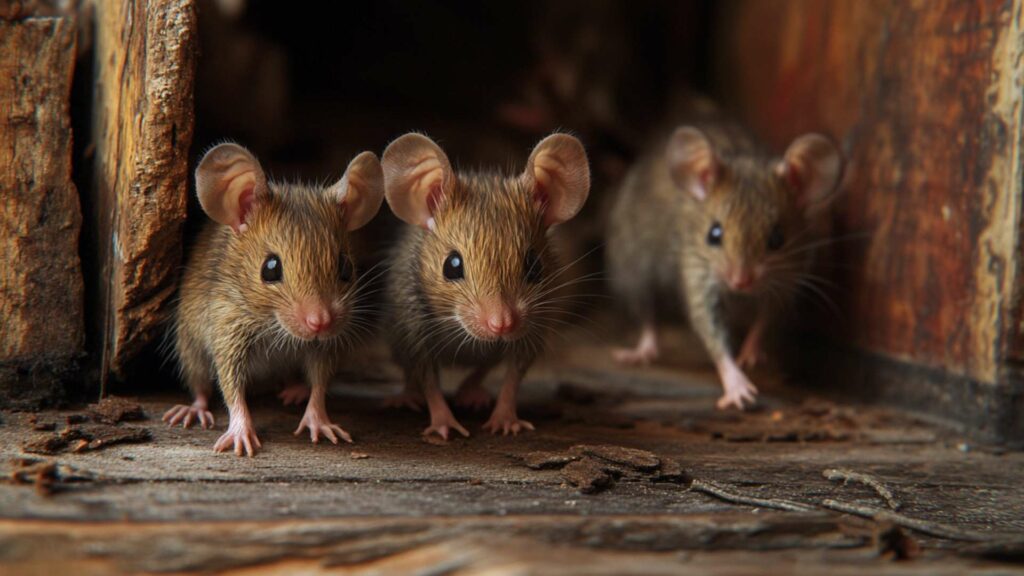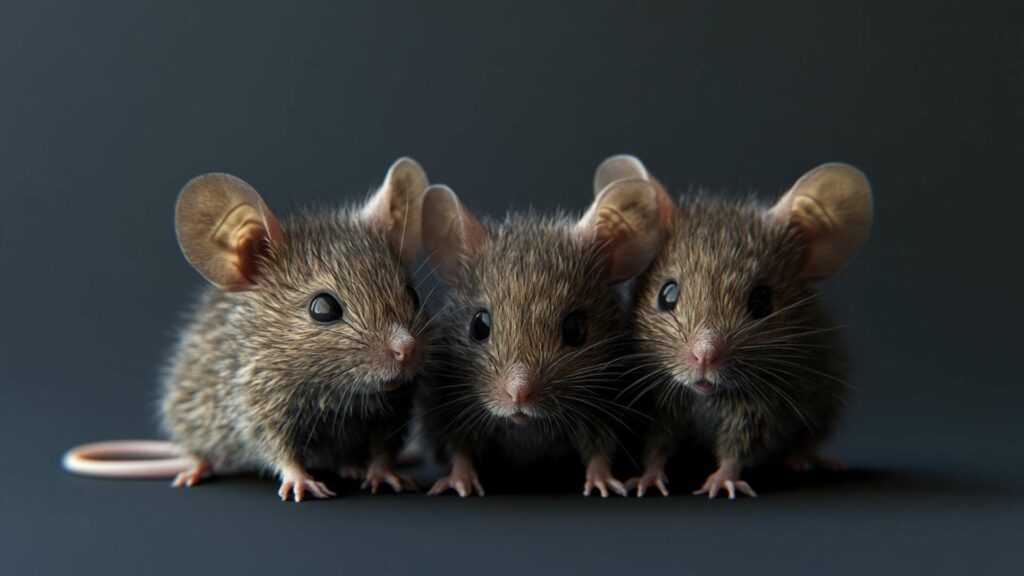Common diseases carried by mice
Introduction: The Hidden Dangers of Mice

Mice are common household pests that can cause problems in many ways. For example, they can eat your food, chew on electrical wires, and make irritating noises at night.
However, one of the most serious issues associated with mice is the fact that they can carry many diseases that are harmful to humans. This is why it’s important to be aware of the risks associated with mice and take steps to prevent exposure to these diseases.
Concerned about the health risks posed by mice in your home? Learn about the hidden dangers and diseases associated with mice in our comprehensive article on Uninvited Guests: The Hidden Health Risks And Diseases Lurking In Your Home’s Mouse Population. Stay informed and protect your well-being!
Importance of Understanding Diseases Carried by Mice
Many people don’t realize just how dangerous mice can be when it comes to carrying diseases. In fact, they are known carriers of a wide variety of different illnesses that can cause serious illness or even death in some cases.
Some examples include hantavirus, leptospirosis, lymphocytic choriomeningitis virus (LCMV), salmonellosis, Lyme disease, rat-bite fever and plague among others. The primary reason why it is so important to understand these diseases is that early detection and treatment are crucial for preventing further complications.
Many of these illnesses have symptoms that may not appear until several days or weeks after initial exposure. As a result, it’s essential to know what signs to look out for so you can seek medical help as soon as possible if necessary.
Overview of Common Diseases Carried by Mice

There are many different types of diseases carried by mice, but some are more commonly found than others. Hantavirus is one such disease that has gained attention in recent years due to its potential for causing respiratory failure in humans. Another example is leptospirosis which is caused by bacteria found in urine droppings from infected rodents such as rats or mice.
Other illnesses like LCMV and salmonellosis are also known to be carried by mice. LCMV is a viral infection that can cause serious illness in people with weakened immune systems, while salmonellosis is a bacterial infection that can cause symptoms like diarrhea and vomiting.
Being aware of the risks associated with these diseases and taking steps to prevent exposure is essential for staying healthy and avoiding the potential complications that can arise from contact with infected rodents. The next few sections will provide more detail on some of the most common diseases carried by mice, including their symptoms, transmission methods, and prevention strategies.
Hantavirus: Understanding the Symptoms and Transmission
Hantavirus is a severe respiratory disease caused by several viruses transmitted through contact with infected rodents. The most common type of Hantavirus in the United States is known as hantavirus pulmonary syndrome (HPS), which affects the lungs, leading to difficulties in breathing. The symptoms include fever, muscle aches, fatigue, and dizziness.
In some cases, nausea and vomiting may occur. The transmission of the Hantavirus infection occurs through contact with infected wild mice’s urine droppings or saliva.
Humans usually come into contact with the virus when they are cleaning up rodent droppings or nesting areas. Notably, pregnant females are at higher risk of contracting Hantavirus because their immune system is weakened during pregnancy.
Prevention Methods: Protecting Yourself from Hantavirus
To prevent contracting Hantavirus, it’s essential to reduce exposure to rodents in your home or workplace. You can start by keeping your surroundings clean and free from rodent activity. Make sure you store food items in rodent-proof containers to avoid attracting rats or other rodents.
If you suspect any rodent activity around your home or office, use a spray bottle filled with bleach to disinfect surfaces that may have come into contact with rodent droppings or urine. Avoid sweeping up dried-up droppings as it can cause airborne contamination.
It’s also recommended that you avoid petting or handling wild mice or rats as they can transmit the virus through bites or scratches. In case you develop any symptoms of HPS within 1-5 weeks after exposure to infected animals or rodents, seek medical attention immediately.
Understanding how Hantavirus spreads and its symptoms is critical for preventing its contraction effectively. By taking measures such as reducing exposure to rodents and maintaining proper hygiene standards around your home or workplace, you can protect yourself from both Hantavirus infections and other bacterial infections.
Leptospirosis: A disease that can be transmitted through mice
Leptospirosis is a disease in humans caused by the bacteria Leptospira, which can be found in the urine or saliva of infected rodents, including mice. This disease can be transmitted to humans who come into contact with contaminated surfaces or water. The severity of leptospirosis can range from mild flu-like symptoms to severe complications that may require treatment in an intensive care unit.
Symptoms of leptospirosis include fever, headache, muscle aches, and vomiting. These symptoms are often mistaken for other common illnesses such as the flu, making it difficult to diagnose without proper testing.
In severe cases, this disease can cause liver damage and kidney failure. To prevent leptospirosis from spreading, it is important to take measures to control rodents in your home or workplace.
This includes sealing any gaps or holes where mice may enter and keeping food stored in rodent-proof containers. Additionally, regularly cleaning surfaces with disinfectants and using a spray bottle filled with a 10% bleach solution on areas that may have been contaminated by mouse urine or saliva can help reduce the risk of infection.
While leptospirosis is not commonly found among house mice in urban environments, it is still important to take precautions when dealing with rodents in your home or workplace. Remember to always wear gloves when handling potentially infected rodents or their droppings and seek medical attention if you experience any flu-like symptoms after coming into contact with them.
Lymphocytic choriomeningitis virus (LCMV)
The Silent Threat: Lymphocytic Choriomeningitis Virus
Lymphocytic choriomeningitis virus (LCMV) is a rodent-borne viral disease that can be transmitted to humans through contaminated food, water, and contact with infected pet rodents or wild mice. The symptoms of LCMV are often mild and flu-like, including fever, muscle pain, headache, nausea and vomiting.
However, in some cases it can lead to serious neurological complications such as meningitis or encephalitis. Transmission of LCMV occurs primarily through exposure to urine, blood or saliva of infected rodents.
People can become infected by touching surfaces contaminated with the virus or by breathing in dust containing infectious particles from rodent nests or droppings. In rare cases people have gotten infected from eating food contaminated with the virus.
Prevention methods
The best way to prevent infection is by avoiding contact with rodents and their excreta. Control rodent activity around your home by blocking entry points such as doors and windows that don’t close properly.
Clean up any spilled pet food or birdseed, remove dead rodents promptly using gloves and disinfect areas where they have been found. If you keep pet rodents make sure they are healthy and clean their cages regularly.
Always wash your hands thoroughly after handling pets or cleaning their cages- especially if you have been bitten. Pregnant women should avoid contact with all types of rodents due to an increased risk for miscarriage if they become infected.
There is no cure for LCMV but supportive treatment can help manage symptoms like fever and muscle pain while the body fights off the infection. In severe cases it may require hospitalization for monitoring until recovery occurs on its own without intervention.
The Dangers of Salmonellosis from Mice
Mice are common carriers of salmonella, a bacteria that can cause serious illness in humans. While salmonella is commonly associated with food poisoning, it can also be transmitted through contact with rodents and their droppings.
The symptoms of salmonellosis include fever, diarrhea, abdominal cramps, and vomiting. In some cases, the disease progresses to more severe symptoms including difficulty breathing and blood infections.
Symptoms and Transmission
Salmonella is typically spread through direct contact with infected rodent bites or rodent urine and droppings. It can also be spread indirectly through contaminated food or water sources.
The symptoms of salmonellosis usually appear within 12-72 hours after exposure to the bacteria, although some people may not experience any symptoms at all. Salmonellosis is most commonly associated with the common house mouse but can also be found in deer mice.
Prevention Methods
To prevent the spread of salmonella from rodents to humans, it’s important to keep areas where mice are likely to live clean and free from rodent waste. Wear gloves when cleaning up rodent droppings or urine and avoid sweeping or vacuuming them which can stir up harmful dust particles into the air that you could inhale. Keep your home well-ventilated by opening windows regularly to keep fresh air circulating throughout your living space.
It’s important for pregnant women and those with weakened immune systems to take extra precautions since they’re at higher risk for serious complications from a Salmonella infection caused by contact with rodents like mice or rats. There is no specific treatment for salmonellosis other than rest and rehydration but if you have been exposed then see your doctor immediately as they may want prescribe antibiotics if it was contracted through something ingested orally like contaminated food rather than through direct contact.
Lyme Disease: The Infection with a Wide Range of Symptoms
Early Symptoms & Transmission
Lyme disease is an infection that can be transmitted to humans by black-legged ticks infected with the bacterium Borrelia burgdorferi. Though it is not directly transmitted by rodents, mice act as a host for these ticks, making them one of the primary carriers of Lyme disease.
The early symptoms include fatigue, headache, fever, and skin rash called erythema migrans that appears within 7-10 days at the site of the tick bite. The disease progresses to affect joints, heart and nervous system if left untreated.
People get infected through bites from black-legged ticks also known as deer ticks that have been affected by mice. Other ways of getting infected are having direct contact with infected rodent, feces or urine, kitty litter or pet bedding contaminated with infectious material from rodents.
Prevention Methods
To prevent Lyme disease transmission through rodents and their primary hosts (ticks), avoid nesting materials such as leaves/grass piles near homes and keep your grass short. You should also use tick repellents on exposed skin and clothes when going for outdoor activities in areas known to have high tick populations. If you find a tick attached to you or your pet’s skin remove it immediately using tweezers without twisting or crushing it.
Wash the area thoroughly with soap and water after removal to minimize infection risks. If you develop symptoms associated with Lyme disease after exposure, seek specific treatment from your doctor since early diagnosis increases chances of full recovery.
Takeaway
Lyme disease can be severe if left untreated, but there are many prevention methods you can implement to protect yourself including avoiding high-risk areas during peak tick seasons which typically occur in Spring through early Fall months each year. By taking these precautions, you can significantly reduce your chances of contracting Lyme disease and other tick-borne illnesses associated with rodents.
Rat-Bite Fever: The Disease You Can Get From Your Pet Mice

Have you ever thought that your cute little pet mice could carry diseases? Unfortunately, it’s true.
Rat-bite fever (RBF) is a disease caused by bacteria called Streptobacillus moniliformis, which can be transmitted to humans through bites or scratches from infected rodents such as house mice or rats. Symptoms of RBF include fever, muscle pain, and skin rash.
Symptoms and Transmission
The symptoms of rat-bite fever usually develop 3-10 days after exposure to an infected rodent. RBF symptoms include high fever, chills, headache, muscle aches, joint pain and vomiting.
A rash may also develop on the hands and feet after a few days of the onset of other symptoms. The disease is transmitted through direct contact with infected rodents or their contaminated materials like urine or droppings.
Humans can also get RBF by consuming contaminated food or water. Individuals who handle wild rodents or other animals such as deer mice without protective gear are also at high risk for getting Rat-bite fever.
Prevention methods
You can prevent rat-bite fever by taking simple precautions while handling rodents. Avoid touching wild rodents with your bare hands; wear protective gloves instead. Always wash your hands carefully after handling any kind of rodent and keep them away from your face and mouth.
If you have pet mice in the house, keep them in clean cages and make sure they don’t come into contact with wild rodents such as deer mice which are carriers of several other diseases including hantavirus infection and LCMV infection. Also ensure that all food containers are tightly sealed to prevent contamination from any nearby rats or other carriers of disease.
Keep all food items in rodent-proof containers so that they cannot be accessed by these pests. Always use a spray bottle of water to clean any surfaces where rodent droppings have been seen to prevent the spread of these diseases.
Rat-bite fever can be treated with antibiotics and other specific treatment. Therefore, it is important to recognize the symptoms and seek medical attention if you have been in contact with infected rodents.
Plague: The Black Death

One of the deadliest diseases carried by mice is the bubonic plague. Historically known as “The Black Death,” this bacterial infection was responsible for wiping out nearly 50% of Europe’s population in the 14th century.
Today, it is rare and can be treated with antibiotics. Symptoms of the plague include fever, chills, headache, and painful lymph nodes.
The bacteria are usually transmitted through rodent flea bites or direct contact with infected rodents or their urine or feces. People at higher risk include those living in areas with rodent infestations, hunters, hikers and campers who spend time outdoors in areas where rodents may be present.
Prevention methods include keeping rodent infestations under control through sanitation and pest control measures. It is also important to avoid direct contact with potentially infected animals and to wear protective clothing when in areas where rodents may be present.
Bubonic vs Pneumonic Plague
There are two forms of the plague: bubonic and pneumonic. While both are caused by the same bacteria, pneumonic plague is much more dangerous because it can be spread through respiratory droplets from an infected person or animal.
This means that it can easily turn into an epidemic if not contained early on. The symptoms of pneumonic plague are similar to those of the bubonic plague but can progress much more quickly.
Patients may also experience coughing up blood or chest pain. Treatment typically involves a course of antibiotics along with supportive treatment such as oxygen therapy.
Lessons from History
Although it may seem like a disease from a bygone era, outbreaks of the plague still occur today in certain parts of the world such as Africa and Asia. With modern medicine and public health measures it is much less deadly than it used to be but remains a serious concern. By understanding the symptoms and transmission of the disease, we can work to prevent future outbreaks and protect ourselves from this deadly disease.
Other diseases carried by mice (brief overview)
The Role of Rats in Spreading Diseases
While the common house mouse is notorious for its ability to spread disease, rats also play a significant role in transmitting diseases to humans. Rats are known to carry a variety of harmful bacteria and viruses, including leptospirosis and salmonellosis.
Leptospirosis is a bacterial infection that can be transmitted through contact with infected urine or contaminated water. Symptoms include fever, chills, muscle pain, and headache.
In severe cases, the infection can lead to respiratory failure or even death. Salmonellosis is caused by eating food contaminated with Salmonella bacteria.
Symptoms include diarrhea, fever, and abdominal cramps. Pregnant females who contract salmonellosis could experience birth defects in their offspring.
Hantavirus: A Potentially Deadly Disease
Hantavirus is another disease commonly carried by mice. The virus is typically transmitted through rodent urine or saliva. Early on symptoms of hantavirus can include flu-like symptoms such as fever and muscle aches.
However, the virus can progress rapidly to Hantavirus Pulmonary Syndrome (HPS), which causes shortness of breath and respiratory failure. Prevention methods for hantavirus include keeping areas clean where rodent activity has occurred, sealing up any potential entry points for rodents into buildings or homes and being cautious when cleaning up rodent droppings or nests.
Bubonic Plague: A Historic Disease Still Present Today
Most people associate bubonic plague with medieval times but this disease still exists today; it’s often referred to as “the black death.” Bubonic plague is transmitted through fleas that have bitten an infected rat or other animal like squirrels or prairie dogs. Symptoms include fever, chills, weakness, swollen lymph nodes — called buboes — and sudden onset of flu-like symptoms.
It can be treated with antibiotics, but early diagnosis is key. In order to prevent bubonic plague or other rodent-related diseases, it’s important to keep areas clean where rodents may frequent, seal up any potential entry points for rodents into buildings or homes, and be cautious when cleaning up rodent droppings or nests.
Conclusion: Protect Yourself and Your Family from Mouse-Borne Diseases
If you have rodents in your home, take measures to protect yourself and your family from the many diseases they can carry. Remember that infected rodents can transmit diseases through urine droppings, saliva, or bites.
Some common diseases caused by mice include Hantavirus, Leptospirosis, Lymphocytic choriomeningitis virus (LCMV), Salmonellosis, Lyme disease, Rat-bite fever and Plague. To avoid being exposed to rodent-borne illnesses:
Keep Your Home Rodent-Proof
One of the best ways to prevent rodent infestations is to keep them out of your home in the first place. Seal cracks and holes in your home’s exterior with caulk or steel wool.
Replace weatherstripping around doors and windows. Keep food in sealed containers and clean up spills promptly.
Dispose of Dead Rodents Properly
If you find a dead rodent, mouse or rat on your property or in your home, do not pick it up with your bare hands! Use gloves or a plastic bag turned inside out to remove it from the area. Seal it tightly in a plastic bag before disposing of it.
Clean Up After Rodents
If you have had a rodent infestation indoors or outdoors, clean up any areas where they’ve been active. This includes sweeping up droppings and nesting materials with a wet mop or towel; disinfecting surfaces that may have come into contact with rodents; ventilating enclosed spaces for at least 30 minutes prior to cleaning them; wearing gloves during cleanup efforts; washing hands thoroughly afterward.
While mice are commonly found pests throughout the world that can transmit many serious illnesses to humans, with proper prevention methods, you can protect yourself and your family from rodent-borne diseases. Taking simple steps like keeping your home rodent-proof, disposing of dead rodents properly, and cleaning up after rodent activity can go a long way in safeguarding your health.
Get rid of rats and mice with D-Termination: the top-notch pest control service in Las Vegas.

Are you exhausted from dealing with rats and mice on your Las Vegas property? D-Termination is the solution you need. Our team of experts specializes in eliminating these troublesome rodents, bringing back peace to your space. Bid farewell to rat and mouse problems and opt for D-Termination today for effective pest control!
Contact us at 702-919-6310 or visit dtermination.com to book your rodent control service and reclaim your space from unwanted guests.
Frequently Asked Questions:
The initial signs of hantavirus may include fatigue, fever, muscle aches, and dizziness.
The odds of getting hantavirus are relatively low, as it is primarily transmitted through contact with infected rodents.
Yes, it is possible to survive hantavirus. However, it can be a serious and potentially life-threatening illness, so prompt medical attention is crucial.
It is relatively common for mice to carry diseases, including hantavirus. It is important to take precautions when dealing with mice or their droppings to minimize the risk of disease transmission.
If you found this article enjoyable, you might also find interest in the following recommendations:
Mice In The House: The Silent Hazards Lurking In Your Home
Unwelcome Guests: Identifying And Preventing Mouse-Borne Diseases In Humans And Pets







